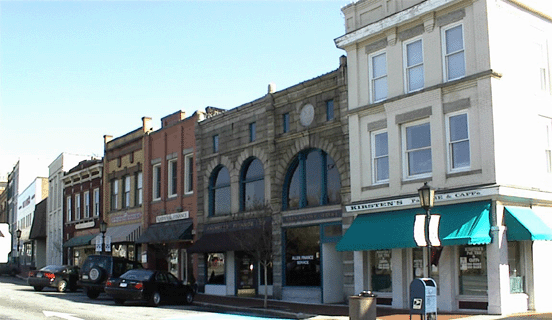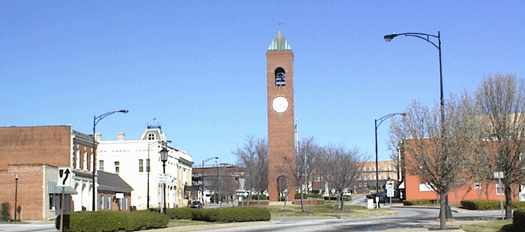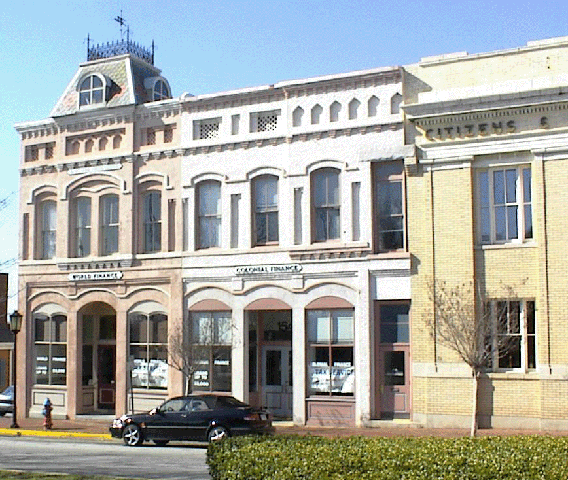 | Asheville business & community directory |
|
This is an archived page that may contain outdated or incorrect information. Please visit www.Asheville.com for the latest news, events, and more.
The turn-of-the-century F. T. Cantrell Wagon Works building, located at 106 West Main Street, in Spartangurg, S.C., has recently undergone an extensive retrofit, and has reopened for business.  However, with the demise of the horse and carriage and mule and wagon for transportation and shipping, the new owners of the F. T. Cantrell Wagon Works building had to find another form of commerce to support their $600,000 restoration effort.
The combination of apartments upstairs and retail/commercial space downstairs appears to be the right-mix for the building that formerly was used for wagon and carriage sales and repairs. Royce Camp, part-owner, says, "We have five townhouses upstairs, each with between 900 and 1,100 square feet of living space. We have already been able to rent four of the five units for between $500 and $750 in monthly rent."
According to Camp, the apartments have the original hardwood floors, modern kitchens, bathrooms, central heat and air, new wiring and plumbing, and provide some very elegant residential space for people who want to reside in downtown Spartanburg's urban setting. Each apartment is also equipped with a washer and dryer. Camp says the demand for the downtown residential units is so strong that he could lease more residential units if he had them available. However, with the demise of the horse and carriage and mule and wagon for transportation and shipping, the new owners of the F. T. Cantrell Wagon Works building had to find another form of commerce to support their $600,000 restoration effort.
The combination of apartments upstairs and retail/commercial space downstairs appears to be the right-mix for the building that formerly was used for wagon and carriage sales and repairs. Royce Camp, part-owner, says, "We have five townhouses upstairs, each with between 900 and 1,100 square feet of living space. We have already been able to rent four of the five units for between $500 and $750 in monthly rent."
According to Camp, the apartments have the original hardwood floors, modern kitchens, bathrooms, central heat and air, new wiring and plumbing, and provide some very elegant residential space for people who want to reside in downtown Spartanburg's urban setting. Each apartment is also equipped with a washer and dryer. Camp says the demand for the downtown residential units is so strong that he could lease more residential units if he had them available.  Camp added, "We are being very careful about the type of tenant we lease the first floor commercial space to because we do not want to disturb the peace and quiet of the residents who have leased the apartments upstairs. We think that a sandwich shop or bakery would be an ideal mix with the upstairs residential units. However, we want to avoid the type of commercial tenant that will keep late hours and, perhaps, have live music like a pub or nightclub.
The first floor has a total of 2,500 square feet of commercial space, and is available for lease for $2,500 per month.
The restoration of the F. T. Cantrell Wagon Works Building was made possible by several financial incentives that are available to downtown historic restoration projects. The first financial incentive that Camp and his partner, Tim Cantrell, took advantage of was a fa�ade grant. This grant helps pay for the restoration of two of the exterior facades of an historic building by providing a $10,000 grant for each of the two sides restored. In the case of the F. T. Cantrell Wagon Works building, the front and rear facades were restored to their original condition.
Camp added, "We are being very careful about the type of tenant we lease the first floor commercial space to because we do not want to disturb the peace and quiet of the residents who have leased the apartments upstairs. We think that a sandwich shop or bakery would be an ideal mix with the upstairs residential units. However, we want to avoid the type of commercial tenant that will keep late hours and, perhaps, have live music like a pub or nightclub.
The first floor has a total of 2,500 square feet of commercial space, and is available for lease for $2,500 per month.
The restoration of the F. T. Cantrell Wagon Works Building was made possible by several financial incentives that are available to downtown historic restoration projects. The first financial incentive that Camp and his partner, Tim Cantrell, took advantage of was a fa�ade grant. This grant helps pay for the restoration of two of the exterior facades of an historic building by providing a $10,000 grant for each of the two sides restored. In the case of the F. T. Cantrell Wagon Works building, the front and rear facades were restored to their original condition.  The second financial incentive that was used to offset the costs of restoring the F. T. Cantrell building was a residential rebate program. This program offers a $6,000/unit grant for providing residential units in the downtown Spartanburg area. This program is administered by the City of Spartanburg, and uses block grant money from the federal government to fund the program. The program is limited to 5 units per project.
The final, and most important, financial incentive that is being used to offset the costs of this restoration project is the 20 percent federal and 20 percent state tax credits that are available to all restoration projects for properties that are listed on the National Register of Historic Places. The F. T. Cantrell building is about to be approved by the U. S. Department of the Interior for nomination for the National Register of Historic Places.
When the nomination for the National Register of Historic Places is finalized, the developers will be eligible for $120,000 in federal tax credits and $120,000 in state tax credits. These tax credits can be used against the owner's state and federal income taxes that they may incur over the next five years.
The second financial incentive that was used to offset the costs of restoring the F. T. Cantrell building was a residential rebate program. This program offers a $6,000/unit grant for providing residential units in the downtown Spartanburg area. This program is administered by the City of Spartanburg, and uses block grant money from the federal government to fund the program. The program is limited to 5 units per project.
The final, and most important, financial incentive that is being used to offset the costs of this restoration project is the 20 percent federal and 20 percent state tax credits that are available to all restoration projects for properties that are listed on the National Register of Historic Places. The F. T. Cantrell building is about to be approved by the U. S. Department of the Interior for nomination for the National Register of Historic Places.
When the nomination for the National Register of Historic Places is finalized, the developers will be eligible for $120,000 in federal tax credits and $120,000 in state tax credits. These tax credits can be used against the owner's state and federal income taxes that they may incur over the next five years. The financial incentives that the two owners will receive for undertaking the restoration of the F. T. Cantrell building total approximately $290,000. Camp says, "Without these financial incentives, we would never have been able to justify the $600,000 in restoration costs that we expended on this project. As it stands now, we still have a $310,000 net investment on which we have to produce a reasonable annual return. With all of the financial incentives that we have taken advantage of to help pay for this restoration project, the return on our investment should be fairly attractive."
Camp also added, "We have saved an important historic structure located at the gateway of downtown Spartanburg, and this, in itself, gives the project a great deal of merit. These vintage buildings represent part of our heritage in Spartanburg, and preserving one of these buildings saves part of our heritage. Our heritage is something that should be meaningful to everyone."
The financial incentives that the two owners will receive for undertaking the restoration of the F. T. Cantrell building total approximately $290,000. Camp says, "Without these financial incentives, we would never have been able to justify the $600,000 in restoration costs that we expended on this project. As it stands now, we still have a $310,000 net investment on which we have to produce a reasonable annual return. With all of the financial incentives that we have taken advantage of to help pay for this restoration project, the return on our investment should be fairly attractive."
Camp also added, "We have saved an important historic structure located at the gateway of downtown Spartanburg, and this, in itself, gives the project a great deal of merit. These vintage buildings represent part of our heritage in Spartanburg, and preserving one of these buildings saves part of our heritage. Our heritage is something that should be meaningful to everyone."
all contents copyright © 1999, asheville.com. contact: [email protected] or 828.253.2880 For listing and advertising information...
|
